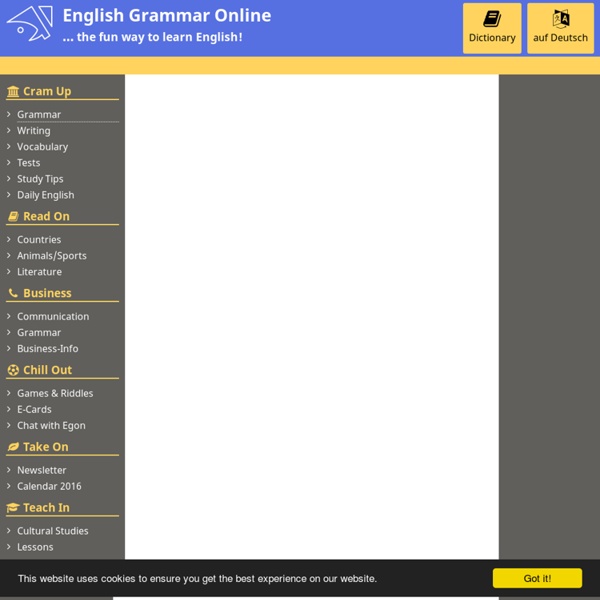Participle Clauses 1
Reduced Relative Clauses (Download this page in PDF here.) (Click here for information about participle adjectives.) We can use participle clauses after a noun in the same way as relative clauses.
In Spite of, Despite and Although
‘in spite of’, ‘despite’ and ‘although’ are all used to show contrast and are used for the same meaning. The only difference is the way they are used; the structure in which they are used. ‘in spite of’ and ‘despite’ are placed in front of a noun or pronoun: We had a great time in spite of the rain. We had a great time despite the rain. Despite studying very hard, he still didn’t pass the exam.
Use of English: Tenses
Kangaroo injures Australian politician May 18, 2013 A kangaroo (1)(injure) Australian politician Shane Rattenbury in the Australian capital, Canberra, on Thursday. Mr. Rattenbury (2)(take) a morning jog in the Canberra suburb of Ainslie when the kangaroo (3)(surprise) him, and in the ensuing confrontation Mr.
Reading Comprehension Worksheets
ELA Standards: Informational Text View SourceCommon Core Lesson and Unit PlansUnderstanding Common Core State Standards
Upper-intermediate use of English - Exercise 3: Kangaroo injures Australian politician
Kangaroo injures Australian politician Saturday, May 18, 2013A kangaroo injured Australian politician Shane Rattenbury in the Australian (1), Canberra, on Thursday. Mr. Rattenbury was taking a morning (2) in the Canberra suburb of Ainslie when the kangaroo surprised him, and in the ensuing (3), Mr. Rattenbury was scratched several (4) on the leg. By Mr Rattenbury's (5), the kangaroo was an eastern grey kangaroo, which is a common (6) in Australia.
Upper-intermediate use of English - Exercise 3
Woman gives birth on New Jersey PATH train Tuesday, January 17, 2012A New Jersey woman, 31-year-old Rabita Sarker, gave birth on a moving Port Authority Trans-Hudson (PATH) train yesterday morning. She and her husband Aditya Saurabh were heading (1) St. Luke's-Roosevelt Hospital in Manhattan (2) a "practice run". She gave birth (3) the Journal Square and 33rd Street stations at 9:49 am ET.
Advanced English - Grammar Test 1
She shouldn't have broken that glass. Correct IncorrectBut I did do my homework! Correct IncorrectWhere is the book what I got for my birthday? Correct IncorrectWalking in the garden, it began to rain. Correct IncorrectWe were to have tea here. Correct IncorrectShe is a most energetic woman.
Tenses
I can't find my dictionary; I wonder whether Mary _____ it now. have had is having hasI'm sorry, I can't talk to you any longer because I _____ dinner. was making make 'm making 've madeWhile everyone else _____, she _____ quietly in the kitchen. laughed - cryed laughed - was cried was laughed - cried was laughing - was cryingThat house is in a terrible state!
T053-All tenses - English Grammar Exercises
T053-All tenses Gap-fill exercise Fill in all the gaps, then press "Check" to check your answers. Use the "Hint" button to get a free letter if an answer is giving you trouble.
Tenses and forms-English
> BEST RESOURCES: PLACEMENT TEST | GUIDE | OUR BEST WORKSHEETS | Most popular | Contact us > LESSONS AND TESTS: -ing | AS or LIKE | Abbreviations and acronyms... | Adjectives | Adverbs | Agreement/Disagreement | Alphabet | Animals | Articles | Audio test | Be | BE, HAVE, DO, DID, WAS... | Banks, money | Beginners | Betty's adventures | Bilingual dialogues | Business | Buying in a shop | Capital letters | Cars | Celebrations: Thanksgiving, new year... | Clothes | Colours/Colors | Comparisons | Compound words | Conditional and hypothesis | Conjunctions | Contractions | Countries and nationalities | Dates, days, months, seasons | Dictation | Direct/Indirect speech | Diseases | Exclamative sentences! > ABOUT THIS SITE: Copyright Laurent Camus - Learn more / Help / Contact [Terms of use] [Safety tips] | Do not copy or translate - site protected by an international copyright | Cookies | Legal notices. | Our English lessons and tests are 100% free but visitors must pay for Internet access.
English language quiz - narrative tenses - 02
Fill the gaps with the correct form of the verb in brackets. This is a story so you can choose from past simple, past continuous and past perfect tenses. Press "Check" to check your answers. Use the "[?]" button to get a clue. Use the 'hint' button to get the first letter of the missing word.
Narrative Verb Tense Exercise: Past Tenses
Narrative Verb Tense Exercise: Past Tenses Gap-fill exercise Fill in all the gaps, then press "Check" to check your answers. Use the "Hint" button to get a free letter if an answer is giving you trouble. You can also click on the "[?]"
Present Perfect Simple vs Present Perfect Progressive
Exercises and Tests Form See also explanations on Present Perfect Simple and Present Perfect Progressive Use
Past simple / Present perfect (simple / continuous)-English
Learn English > English lessons and exercises > English test #66482: Past simple / Present perfect (simple / continuous) Past simple and Present perfect The past simple is used to talk about completed actions at a particular point in the past, often with dates or times and words like yesterday, last and ago: Kurt went to Canada in 1991.



